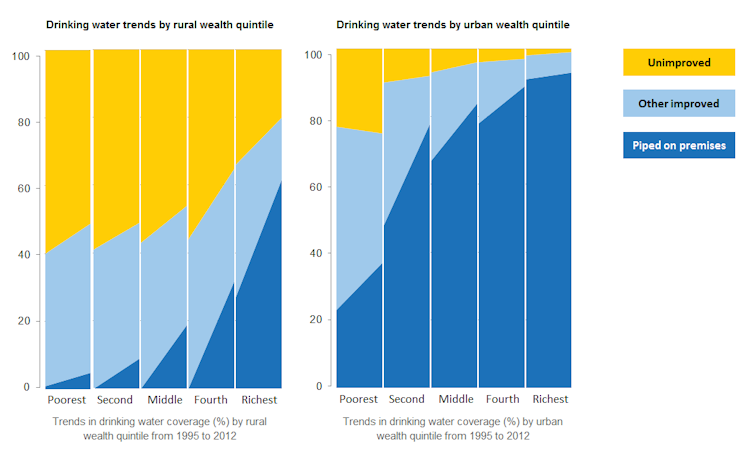The UN’s millennium development goal target of halving the amount of people with access to safe drinking water has been met. The same is sadly not true of the sanitation target. And the transition to the sustainable development goals for water and sanitation has created even more ambitious targets. These will require real change within this sector to achieve them by the 2030 deadline.
Goal 6 of the sustainable development goals, released in 2015, involves ensuring availability and sustainable management of water and sanitation for all. The indicators which will be used to track progress were only agreed in March 2016. It’s early days, so changes and shifts might not be visible to those outside the sector.
I’m happy to report that there are shifts towards greater equity in access – which is important because, as research has previously shown, progress in the provision of water and sanitation tends to benefit wealthier populations. The poor are left out in the cold.
The sustainable development goals aim to provide access to all. but to achieve this will take major changes in the sector.

Equality in access
The millennium development goal focus of halving the number of people without access to water meant that the target could be achieved without helping the poorest. By 2012, the Joint Monitoring Programme, or JMP, analysed progress toward the targets by wealth. This highlighted how progress was often greatest for the wealthiest, while there was little change for the poorest.
Senegal is an example how different progress can be for the richest and poorest in a country which met the MDG target on water. The progress the country made was unequal. In urban areas, access to improved water sources decreased for the poorest between 1995 and 2012. In rural areas, rapid progress for the second wealthiest group still left them 17 years behind that of the wealthiest.
Across the sector there is now a focus on how to extend access to water, sanitation and hygiene services to those who are most marginalised, but also to those who are least able to afford to pay. The target is to make water affordable for all. But this is the one area not currently captured in the SDG indicators. Extending sustainable services to all will require different financing models to address both construction and maintenance, and this remains a key topic under discussion.

A better level of access
There are three key critical areas in which the bar for what is considered access is being raised: safer water quality, integration of hygiene, and safe management of sanitation.
By the end of the MDG period it was clear that improved water sources did not equate to safe drinking water. A rapid assessment of drinking-water quality in five countries – Ethiopia, Jordan, Nicaragua, Nigeria and Tajikistan – demonstrated the gap between improved water sources and safe water. Over half of protected dug wells did not provide safe water and nor did around a third of protected springs and boreholes.
These results showed that in Nigeria the proportion of the population with access to safe water was 15%, or 22 million people lower than estimated based on the MDG indicator. Similar results were found for 4 of the 5 countries included in the study, with a 7-16% decrease in access when water quality was taken into consideration.
Going forward, the SDG indicator for safely managed drinking water services is defined as:
a basic drinking water source which is located on premises, available when needed and free of faecal and priority chemical contamination.
A basic drinking water source is an improved drinking water source with a round trip collection time of no more than 30 minutes including queuing. Where existing data is available, there will be reports against this indicator in the coming year.
But data is not widely available. This will be one of the major outcomes from the SDG for water: millions more people across the globe will have their water sources monitored, with increasing pressure on those that provide water services to ensure water isn’t just available, that it is also safe to drink. The area is already seeing progress with the implementation of water quality testing being expanded in household surveys.
How this data will be made available to water users and decision makers at a local level is not yet clear. But it is essential that this is addressed in the coming years to help deliver safe accessible drinking water for all.
The hygiene gap
There is often limited attention given to hygiene. The inclusion of hygiene in target 6.2 is the result of sustained advocacy and research work within the sector.
About 28 countries in sub-Saharan Africa have been included in surveys demonstrating that, on average, only 13% of the population have access to a handwashing facility at home with soap and water. That is around half the population that had access to sanitation in those same countries, and about one fifth of those with access to water. The inclusion of hygiene in the sustainable development goals will ensure the sector continues to build on this important work.
Safe sanitation
The emphasis in the millennium development goals was on toilet infrastructure only. This has left what has been described as the second generation sanitation challenge: how to remove excreta building up in pit latrines and septic tanks and how to treat it?
Many toilets aren’t accessible to emptying trucks, or are at risk of collapse if they are emptied. Where equipment is available for desludging, waste is still commonly dumped into waterways as treatment works do not have the capacity. Raising awareness of these issues and communicating them through shit flow diagrams is crucial. The sector is changing how it works to address the whole faecal sludge management chain.
The sustainable development goals add new dimensions to evaluating access to drinking water and sanitation, and now hygiene. In the millennium development goals infrastructure was a focus, but with the sustainable development goals it will expand to include management and behaviour change. Progress against the SDG targets for water, sanitation and hygiene may appear slow as these are incorporated into such initiatives.

